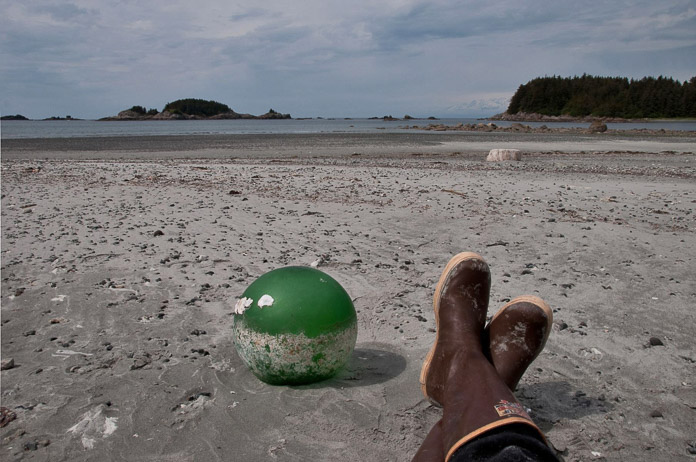
在用塑料鱼漂之前,玻璃球有时会被用来悬浮大渔网。大多数在阿拉斯加发现的玻璃浮子显然是来自于日本渔船。这张照片就是在这个玻璃浮子被发现的地方拍的,Fairweather Range(费尔韦瑟山脉)在照片的背景里。表面看起来几乎是被喷砂过的,底部被藤壶的残留物所覆盖。能幸存这么多年似乎是一个奇迹,也许在北太平洋上漂流了几十年,然后躲过岩石和碎浪的袭击,最后来到了这孤立的沙滩。
Antes de los días de las boyas de plástico, a veces se utilizaban bolas de vidrio para suspender las grandes redes de pesca. Al parecer, la mayoría de las bolas encontradas en Alaska, provienen de barcos de pesca japoneses. Ésta foto muestra una justo donde se encontró, en la costa exterior y con Fairweather Range (la cordillera Fairweather) al fondo. Su superficie parece pulida con chorro de arena, y su fondo está cubierto por restos de percebes. Parece un milagro que haya sobrevivido tantos años, tal vez haya pasado décadas a la deriva en el norte del Pacífico, antes de terminar en esta solitaria playa de arena.
Before the days of plastic fishing floats, glass balls were sometimes used to suspend large fishing nets. Most glass floats found in Alaska are apparently from Japanese fishing vessels. This one is pictured exactly where it was found on the outer coast with the Fairweather Range in the background. The surface looks almost sand-blasted and the bottom is covered with the remnants of barnacles. It seems something of a miracle it survived years, perhaps decades adrift in the North Pacific before weaving a gauntlet of rocks and breakers to end up on this isolated sandy beach. Photographer: Bill Eichenlaub